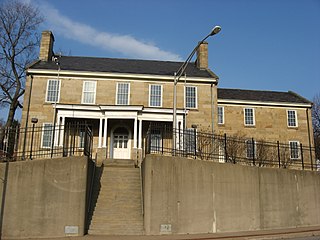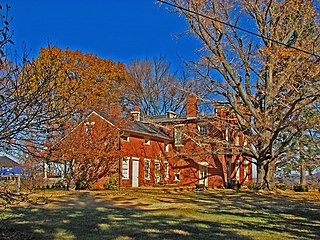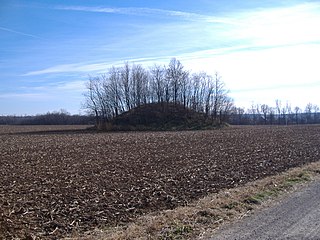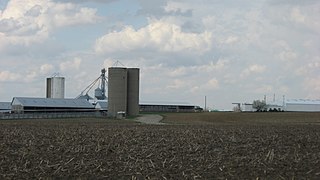Mary Worthington Macomb House | |
Front of the house | |
| Location | 490 S. Paint St., Chillicothe, Ohio |
|---|---|
| Coordinates | 39°19′19″N82°58′48″W / 39.32194°N 82.98000°W Coordinates: 39°19′19″N82°58′48″W / 39.32194°N 82.98000°W |
| Area | 1 acre (0.40 ha) |
| NRHP reference # | 76001525 [1] |
| Added to NRHP | April 26, 1976 |
The Mary Worthington Macomb House is a historic residence in southern Chillicothe, Ohio, United States. Located on South Paint Street, [1] the house sits on the banks of Paint Creek. One of the oldest buildings still in existence in Chillicothe, the Macomb House sits on a land tract of 35 acres (14 ha) that was originally owned by Nathaniel Massie. A later owner started to build the present house in 1813, and it was completed two years later. In the same year, former U.S. Senator and future Governor Thomas Worthington purchased the property. [2]
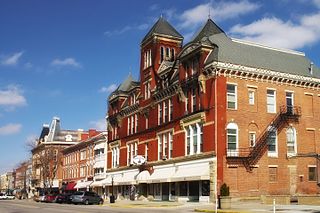
Chillicothe is a city in and the county seat of Ross County, Ohio, United States. Located along the Scioto River 45 miles south of Columbus, Chillicothe was the first and third capital of Ohio.

Ohio is a Midwestern state in the Great Lakes region of the United States. Of the fifty states, it is the 34th largest by area, the seventh most populous, and the tenth most densely populated. The state's capital and largest city is Columbus.

The United States of America (USA), commonly known as the United States or America, is a country comprising 50 states, a federal district, five major self-governing territories, and various possessions. At 3.8 million square miles, the United States is the world's third or fourth largest country by total area and is slightly smaller than the entire continent of Europe's 3.9 million square miles. With a population of over 327 million people, the U.S. is the third most populous country. The capital is Washington, D.C., and the largest city by population is New York City. Forty-eight states and the capital's federal district are contiguous in North America between Canada and Mexico. The State of Alaska is in the northwest corner of North America, bordered by Canada to the east and across the Bering Strait from Russia to the west. The State of Hawaii is an archipelago in the mid-Pacific Ocean. The U.S. territories are scattered about the Pacific Ocean and the Caribbean Sea, stretching across nine official time zones. The extremely diverse geography, climate, and wildlife of the United States make it one of the world's 17 megadiverse countries.
The oldest of Governor Worthington's daughters was Mary, who was born in 1797. [3] Although Mary and her family lived in the grand Adena Mansion on Chillicothe's northern side, [4] she chose to marry lower in society circa 1816. Her new husband, David Macomb, was a member of a prominent local family, but his poor management of their property forced them into debt, and they settled in the southern United States, where Mary died while moving to Texas in 1836. [3] Before moving southward, the Macombs resided in the present two-story house, which is built primarily of large blocks of sandstone. [2]
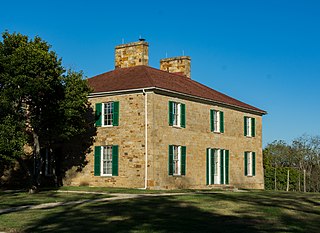
Adena Mansion was built for Thomas Worthington by Benjamin Latrobe, and was completed in 1807. It is located on a hilltop west of downtown Chillicothe, Ohio, United States. The property surrounding the mansion included the location of the first mound found to belong to the Adena culture and thus the Adena mansion is the namesake for the Adena people. The state coat of arms is thought to depict the view of Mount Logan from the Adena property. Adena Mansion is often open for visitors for a small fee.

Texas is the second largest state in the United States by both area and population. Geographically located in the South Central region of the country, Texas shares borders with the U.S. states of Louisiana to the east, Arkansas to the northeast, Oklahoma to the north, New Mexico to the west, and the Mexican states of Chihuahua, Coahuila, Nuevo León, and Tamaulipas to the southwest, while the Gulf of Mexico is to the southeast.
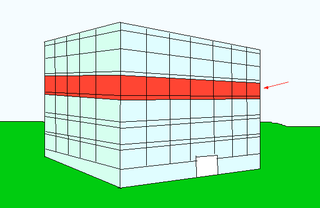
A storey or story is any level part of a building with a floor that could be used by people. The plurals are "storeys" and "stories", respectively.
After the Macombs' departure, the property was converted for industrial uses. By 1845, multiple new buildings arose around the old structure, including a frame building and a slaughterhouse. [2] These buildings are no longer on the property. [1] In 1976, the Macomb House was listed on the National Register of Historic Places, [1] qualifying both because of its historically important architecture and because of its place in local history: most significant were its architecture, its role in commerce, and its place in the exploration and settlement of the local area. [5] By the early twenty-first century, the house had deteriorated greatly; with the proposal of an influx of money from the American Recovery and Reinvestment Act of 2009, applications were made for stimulus dollars to restore the house, and a complete restoration was estimated to cost approximately $500,000. [6]

A slaughterhouse or abattoir is a facility where animals are slaughtered, most often to provide food for humans. Slaughterhouses supply meat, which then becomes the responsibility of a packaging facility.

The National Register of Historic Places (NRHP) is the United States federal government's official list of districts, sites, buildings, structures, and objects deemed worthy of preservation for their historical significance. A property listed in the National Register, or located within a National Register Historic District, may qualify for tax incentives derived from the total value of expenses incurred preserving the property.

The American Recovery and Reinvestment Act of 2009 (ARRA), nicknamed the Recovery Act, was a stimulus package enacted by the 111th U.S. Congress and signed into law by President Barack Obama in February 2009. Developed in response to the Great Recession, the ARRA's primary objective was to save existing jobs and create new ones as soon as possible. Other objectives were to provide temporary relief programs for those most affected by the recession and invest in infrastructure, education, health, and renewable energy.









